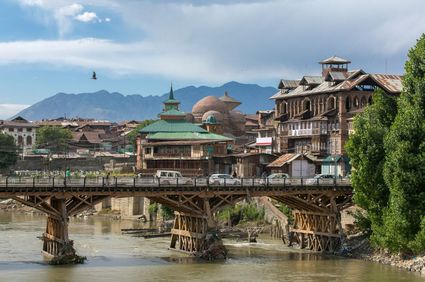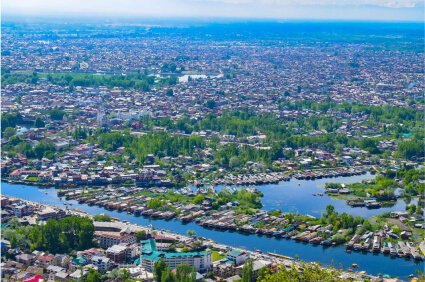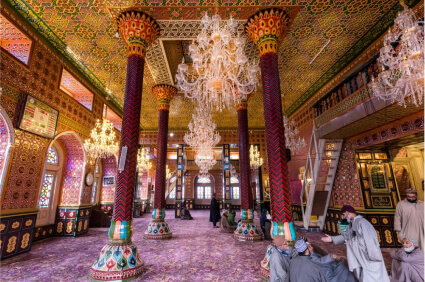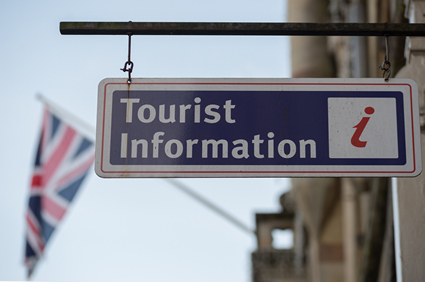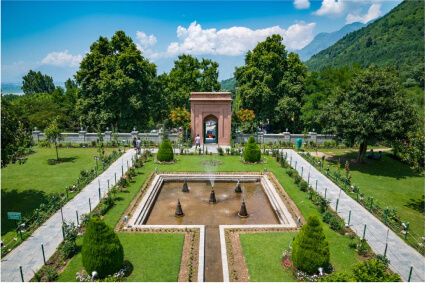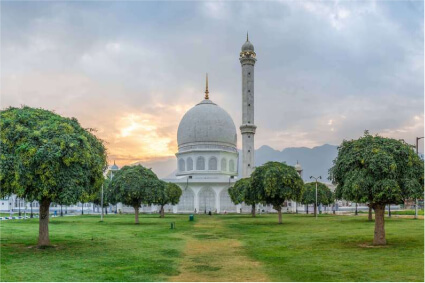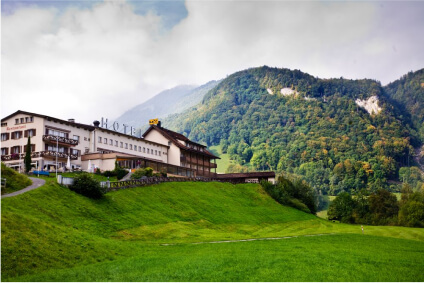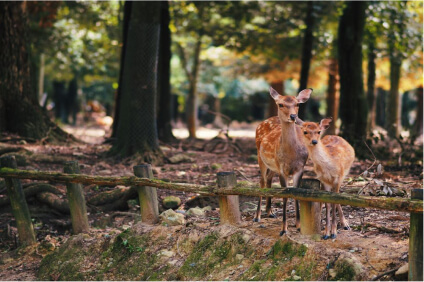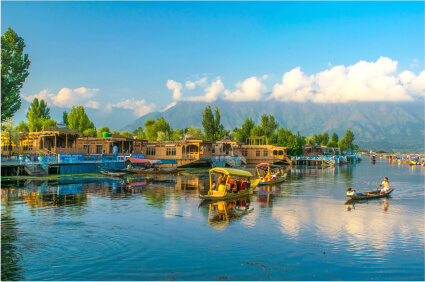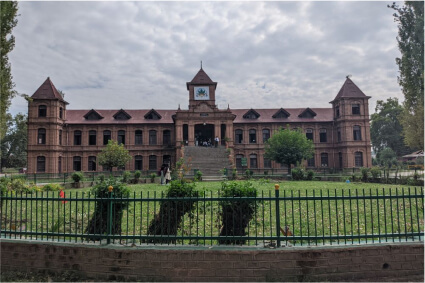TOURIST PLACES AND SIGHTSEEING IN SRINAGAR
1. Dal Lake:
This iconic lake is famous for its houseboats and shikara rides. Gliding across the tranquil waters, surrounded by snow-capped mountains and floating gardens, is a unique experience. The houseboats offer a unique stay experience, and the shikaras (traditional wooden boats) take you on leisurely tours around the lake.
2. Nigeen Lake:
A quieter counterpart to Dal Lake, Nigeen Lake is equally enchanting. It’s a serene lake bordered by lush greenery and charming houseboats. Take a shikara ride here to experience the calm beauty away from the bustling city.
3. Shalimar Bagh:
This Mughal garden is a masterpiece of terraced lawns, cascading fountains, and vibrant flowerbeds. Built by Emperor Jahangir, it’s a delightful place for a leisurely stroll and a glimpse into the opulence of Mughal architecture.
4. Shankaracharya Temple:
Perched atop a hill, this ancient temple offers panoramic views of Srinagar. The climb is worth it, not only for the spiritual experience but also for the breathtaking vistas of the city, Dal Lake, and the surrounding mountains.
5. Pari Mahal:
Also known as the Palace of Fairies, Pari Mahal is a historic monument with terraced gardens. Its architecture blends Persian and Mughal styles, and from here, you’ll get the mesmerizing views of Dal Lake and Srinagar city.
6. Hazratbal Shrine:
Situated on the banks of Dal Lake, this revered Muslim shrine houses a relic believed to be a hair strand of Prophet Muhammad. The white marble structure when witnessed against the backdrop of the lake is a sight to behold.
7. Chashme Shahi:
Another delightful Mughal garden, Chashme Shahi is famous for its natural spring that feeds a series of cascades and terraced pools. The cool, refreshing ambiance makes it a perfect spot to unwind.
8. Jamia Masjid:
This grand mosque stands as a testament to Kashmiri wooden architecture. Its beautifully carved pillars and serene courtyard invite visitors to appreciate its architectural beauty and spiritual significance.
9. Indira Gandhi Memorial Tulip Garden:
Spread across the foothills of Zabarwan Range, this Asia’s largest tulip garden bursts into colorful blooms during spring. Stroll through rows of tulips, capturing Instagram-worthy moments against the backdrop of the Zabarwan hills.
10. Mughal Gardens:
These gardens, including Nishat Bagh and Shalimar Bagh, showcase the grandeur of Mughal architecture. Nishat Bagh, with its terraces, water channels, and flowering plants, is a visual delight.
11. Floating Vegetable Market:
Amidst the tranquil waters of Dal Lake, boats laden with vibrant produce sway gently. Here, the rhythm of life is set by the lapping waves and the calls of vendors. As dawn breaks, the Floating Vegetable Market awakens—a kaleidoscope of colors.
12. Old City:
Step into a maze of time-worn alleys, where centuries whisper secrets. The Old City cradles ancient homes adorned with wooden balconies, their intricate carvings telling tales of love and loss. As you wander, the scent of cardamom tea mingles with the echoes of forgotten poets. Each cobblestone holds memories—of silk traders, spice merchants, and lovers who met under moonlit archways.
13. Lal Chowk:
In the heart of Srinagar, Lal Chowk pulses with energy. Here, the bazaars spill over with treasures, saffron strands, intricately woven Pashmina shawls, and the warmth of freshly baked Kashmiri bread. As the sun dips below the Himalayan peaks, the market comes alive. Follow the aroma of kehwa—a fragrant blend of spices—and lose yourself in the symphony of haggling voices.
14. Dachigam National Park:
Venture beyond the city’s edge, where the rugged terrain cradles Dachigam National Park. Amongst pine-scented forests, elusive Hanguls—the regal Kashmiri stags—graze. Their antlers, like the crescent moon, pierce the mist. Keep your eyes peeled for the black bears—the guardians of these ancient woods. Here, nature whispers its secrets, and time slows to a heartbeat.
15. Hari Parbat Fort:
Atop Hari Parbat hill stands a weathered fort overlooking Srinagar. Its ancient stone walls echo tales of Mughal emperors and Afghan conquerors. As you climb, the valley reveals itself—a mosaic of saffron fields, glistening lakes, and rustic rooftops. Stand on the ramparts, and let the wind carry your hopes across the Zabarwan Range. The view is both a gift and a prayer.
16. Dastgeer Sahab Shrine:
In the heart of Srinagar lies a sanctuary—an embrace of faith and mysticism. Dastgeer Sahab Shrine, dedicated to a Sufi saint, draws pilgrims and seekers. The courtyard echoes with whispered prayers, and incense weaves through the air. Here, time bends—a thread connecting generations. As you touch the marble threshold, feel the pulse of devotion.
17. Kathi Darwaza:
Step through the ancient gateway, where history unfurls like a parchment map. Kathi Darwaza, with its sturdy stone arches, guards the entrance to Srinagar’s bygone era. Each stone bears witness to the passage of time—of traders, warriors, and dreamers who passed this way. The archways frame a view of Srinagar, a city that dances between past and present. As you walk through, imagine the stories that linger in the shadows.
18. Aali Kadal:
Wander along the banks of Aali Kadal, where the waters of the Jhelum River flow serenely. Wooden bridges span the river, and traditional Kashmiri homes line the edges. The daily rhythm of life here is simple yet profound—a testament to the enduring charm of Srinagar’s waterways. Let the gentle lapping of the river soothe your senses as you explore this timeless landscape.
19. Makhdoom Sahib Shrine:
Nestled on a hill, the Makhdoom Sahib Shrine offers a panoramic view of Srinagar. This revered site dedicated to a Sufi saint is a beacon of spiritual serenity. The climb to the shrine is a pilgrimage of its own, with each step bringing you closer to a profound sense of peace. From here, the city unfolds like a tapestry of history and faith.
20. Shalimar Bagh:
This Mughal garden is a masterpiece of terraced lawns, cascading fountains, and vibrant flowerbeds. Built by Emperor Jahangir, it’s a delightful place for a leisurely stroll and a glimpse into the opulence of Mughal architecture.
21. Chinar Bagh:
Amongst the mighty chinar trees, Chinar Bagh blooms—a heritage park. Here, Kashmir’s soul unfurls—a dance of swings, kiosks, and fountains. As dusk settles, an open-air theatre awakens, weaving cultural threads.
22. Boulevard Road:
Follow the lakeside path—the boulevard where dreams linger. The sun kisses your cheeks, and houseboats nod in approval. The Himalayas peek through the mist, and you stroll, hand in hand with beauty. It’s not just a walk; it’s a love affair with Srinagar.
23. Kashmir University Campus:
Nestled near Dal Lake, the University of Kashmir is a magical place with ancient Chinar trees with golden leaves creating pathways. In Naseem Bagh, seasons change—the mosaic of autumn leaves, footsteps of young students, and the smoke from burning leaves. Step into knowledge and nature’s secrets.
24. Char Chinar:
An island with a quartet of chinar trees, their roots touching ancient soil. Char Chinar stands on Dal Lake, a refuge for birds and daydreamers. Here, time slows; the leaves whisper stories. You sit, gazing at the horizon, wondering if paradise is just a boat ride away.
25. Badamwari Garden:
Almond blossoms blush—a mountain embrace. Badamwari offers vistas—snow-kissed peaks cradling the valley. As you wander, inhale the promise of spring. The petals fall like blessings, and you realize—you’re part of this eternal cycle, where seasons weave their magic.
26. Kheer Bhawani Temple:
A temple stands—a goddess’s abode. Kheer Bhawani, nestled near Ganderbal, guards ancient secrets. Devotees gather, seeking blessings. The lotus pond mirrors faith, and as you light a lamp, you feel the goddess’s gaze—a timeless connection.
27. Botanical Garden:
Step into a living encyclopedia—flora whispering tales. Here, ferns share secrets with orchids, and butterflies dance. The air smells of chlorophyll and curiosity. As you explore, remember—you’re a chapter in nature’s book, turning pages with wonder.
28. Royal Springs Golf Course:
Commissioned in 2001 and designed by the American golfer Robert Trent Jones Jr., is a masterpiece nestled against the Zabarwan Mountains in Srinagar, India. With its undulating terrain, well-placed bunkers, and water hazards, this 18-hole course spans 7,089 yards from the back tees. As you tee off, soak in the breathtaking views—the snow-capped peaks, the Dal Lake, and the crisp mountain air.
29. Zero Bridge:
This bridge is like a time traveller. During the day, it stands tall and proud, reflecting in the water like a mirror. But when the sun starts to say goodnight, something enchanting happens. The bridge turns into a glowing dreamland, with soft lights making it look like a fairy tale. So, next time you visit Srinagar, don’t forget to spend some time on Zero Bridge.
30. Foreshore:
Foreshore Road Habbak Srinagar is a scenic boulevard that offers a stunning view of the Dal Lake and its surroundings. Foreshore Road Srinagar is also close to many attractions, such as the Mughal Gardens, the Tulip Gardens, and Harwan garden. Foreshore Road Srinagar is a must-visit destination for anyone who wants to experience the natural beauty, cultural heritage, and modern development of Srinagar.
31. Polo View:
Polo View is a historic and iconic market in the heart of Srinagar. It is a shopper’s delight, offering a variety of Kashmiri arts and crafts, dry fruits, herbal products, and more. Polo View is a pedestrian paradise, with wire-free lanes, chinar trees, and cafes. Polo View is a must-visit destination for anyone who wants to experience the culture, history, and charm of Srinagar.
32. Duck Park:
Duck Park is a beautiful park in Srinagar, located near the Dal Lake. It is a popular tourist attraction, as it has many ducks, swans, and geese that swim and play in the water. The park also has a fountain, a children’s play area, fishing point, and a cafeteria. Duck Park is a place of natural beauty, fun, and relaxation. It is a must-see destination for anyone who wants to enjoy the charm of Srinagar.
33. Astanmarg:
Astanmarg is a green meadow on the Zabarwan range, about 25 kilometers from Lal Chowk in Srinagar. It offers a panoramic view of the city, Dal Lake, and the mountains. It is also a paragliding destination, where tourists can enjoy a thrilling ride from the summit to the Chandpora Cricket Ground. Astanmarg is a place of natural beauty, adventure, and tranquility. It is one of the best viewpoints and offbeat tourist destinations in Srinagar.
34. Pathar Masjid:
Ancient stones cradle faith—a mosque from the Mughal era. Imagine cool marble underfoot, the call to prayer echoing through time. As you kneel, you’re part of a lineage—a seeker seeking solace.
35. Khanqah of Shah Hamdan:
A religious complex where whispers of Shah Hamdan still linger. Imagine courtyards, wooden balconies, and the river Jhelum flowing nearby. Here, faith transcends centuries, and you’re a pilgrim—a seeker of wisdom.
36. Rozabal Shrine:
Some say it cradles a secret—the final resting place of Jesus Christ. Imagine the breeze carrying echoes of ancient travelers. As you stand, you ponder—did he walk these valleys, too? Rozabal Shrine—weaves faith and mystery.
37. Jehlum River:
Embark on a journey of discovery along the lifeblood of Srinagar, the Jehlum River. Cruise on a leisurely boat ride, soaking in the vibrant local life along the banks. Capture picturesque landscapes and immerse yourself in the cultural heart of the city.
38. Harwan Garden:
Step back in time to the Mughal era at the enchanting Harwan Garden. Stroll through meticulously designed terraced lawns, marvel at cascading waterfalls, and be captivated by vibrant flowerbeds bursting with color. Breathe in the fresh mountain air and find tranquility amidst this historical masterpiece.
39. Badshah Tomb:
Journey into the captivating history of Kashmir at the Badshah Tomb. This imposing Mughal-era monument stands as a testament to the region's rich past. Admire the intricate architecture, whispering tales of emperors and battles, and gain a deeper understanding of Srinagar's cultural heritage.
40. Srinagar Cricket Stadium:
Feel the electrifying atmosphere of cricket at the renowned Srinagar Cricket Stadium. Witness the passion of local players in action, cheering on your favorite team amidst a sea of enthusiastic fans. Experience the pulse of this beloved sport in the heart of Kashmir.
41. Hazratbal Friday Market:
Immerse yourself in the vibrant tapestry of Hazratbal Friday Market. Explore a diverse range of local products, from hand-woven shawls to aromatic spices. Discover unique handcrafted souvenirs and tantalize your taste buds with delicious street food. Experience the warmth and charm of local culture in this bustling marketplace.
42. Rainawari:
Step back in time with a captivating walk through the narrow lanes of Rainawari, a historic neighborhood that feels like a living museum. Admire the traditional Kashmiri architecture reflected in the intricately carved wooden houses and bustling shops. Interact with friendly locals, witness their way of life, and soak in the authentic charm of this timeless enclave.
43. SPS Museum:
Embark on a historical journey at the Sri Pratap Singh Museum, a treasure trove housing artifacts, manuscripts, and artworks that unveil the rich cultural and historical heritage of Kashmir. Explore diverse exhibits showcasing ancient weaponry, coins, textiles, and archaeological finds, each piece whispering tales of the region's fascinating past.
44. Floating Post Office:
Experience the world's only floating post office, a charming houseboat nestled on the serene waters of Dal Lake. Send a postcard to your loved ones from this unique location, creating a truly unforgettable memory of your Srinagar visit. Imagine the delight of receiving a postcard with a Srinagar postmark, stamped right on the lake!
45. Floating Gardens:
Witness the marvel of traditional Kashmiri farming on Dal Lake, where vegetables flourish on floating rafts of soil anchored to the lake bed. These "floating gardens" showcase the region's ingenious adaptation to the environment and its resourceful spirit. Learn about the unique cultivation methods and appreciate the vibrant green patches amidst the tranquil lake waters.
46. Five Bridges:
Admire the architectural prowess of Srinagar's Five Bridges, each a testament to the city's cultural heritage. Stroll along the bridges, marvel at their unique designs and historical significance, and capture panoramic views of the Jhelum River and the surrounding cityscape.
47. Iqbal Park:
Seek respite from the city's bustle in the tranquil green haven of Iqbal Park. Nestled on the banks of Dal Lake, this park offers a serene escape with lush lawns, vibrant flower beds, and shaded walkways. Enjoy leisurely strolls, have a picnic lunch under the trees, or simply relax and soak in the peaceful atmosphere.
Experience The Best Sight Seeing Service With Kashmir Online
With Kashmir Online, your travel is not just hassle-free but also tailored to exceed your expectations at every step.

